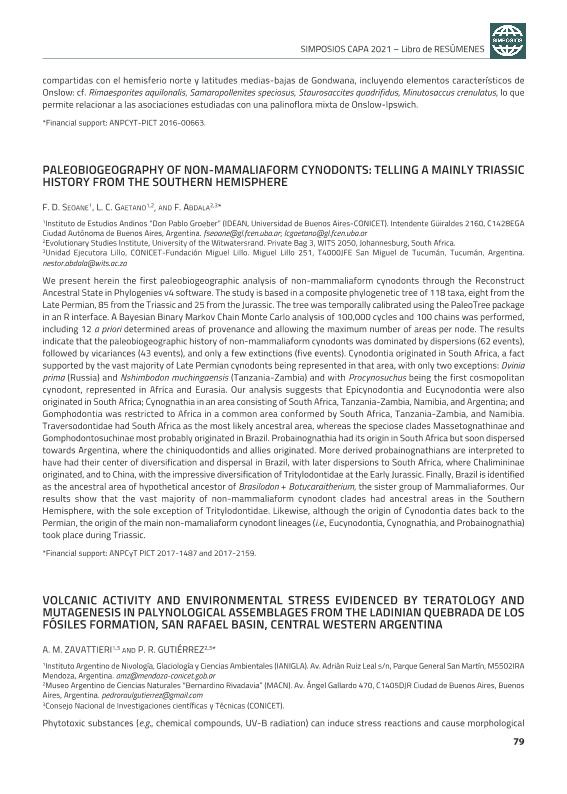Evento
Paleobiogeography of non-mamaliaform cynodonts: telling a mainly Triassic history from the southern hemisphere
Tipo del evento:
Congreso
Nombre del evento:
XII Congreso de la Asociación Paleontológica Argentina
Fecha del evento:
23/11/2021
Institución Organizadora:
Asociación Paleontológica Argentina;
Título de la revista:
Publicación Electrónica de la Asociación Paleontológica Argentina
Editorial:
Asociación Paleontológica Argentina
ISSN:
2469-0228
Idioma:
Inglés
Clasificación temática:
Resumen
We present herein the first paleobiogeographic analysis of non-mammaliaform cynodonts through the Reconstruct Ancestral State in Phylogenies (RASP) v4 software. The study is based in a composite phylogenetic tree of 118 taxa, eight from the Late Permian, 85 from the Triassic and 25 from the Jurassic. The tree was temporally calibrated using the PaleoTree package in an R interface. A Bayesian Binary Markov Chain Monte Carlo (BBM) analysis of 100,000 cycles and 100 chains was performed, including 12 a priori determined areas of provenance and allowing the maximum number of areas per node. The results indicate that the paleobiogeographic history of non-mammaliaform cynodonts was dominated by dispersions (62 events), followed by vicariances (43 events), and only a few extinctions (5 events). Cynodontia originated in South Africa, a fact supported by the vast majority of Late Permian cynodonts being represented in that area, with only two exceptions: Dvinia prima (Russia) and Nshimbodon muchingaensis (Tanzania-Zambia) and with Procynosuchus being the first cosmopolitan cynodont, represented in Africa and Eurasia. Our analysis suggests that Epicynodontia and Eucynodontia were also originated in South Africa; Cynognathia in an area consisting of South Africa, Tanzania-Zambia, Namibia, and Argentina; and Gomphodontia was restricted to the Africa in a common area conformed by South Africa, Tanzania-Zambia, and Namibia. Traversodontidae had South Africa as the most likely ancestral area, whereas the speciose clades Massetognathinae and Gomphodontosuchinae most probably originated in Brazil. Probainognathia had its origin in South Africa but soon dispersed towards Argentina, where the chiniquodontids and allies originated. More derived probainognathians are interpreted to have had their center of diversification and dispersal in Brazil, with later dispersions to South Africa, where Chalimininae originated, and to China, with the impressive diversification of Tritylodontidae at the Early Jurassic. Finally, Brazil is identified as the ancestral area of hypothetical ancestor of Brasilodon + Botucaraitherium, the sister group of Mammaliaformes. Our results show that the vast majority of non-mammaliaform cynodont clades had ancestral areas in the Southern Hemisphere, with the sole exception of Tritylodontidae. Likewise, although the origin of Cynodontia dates back to the Permian, the origin of the main non-mamaliaform cynodont lineages (i.e., Eucynodontia, Cynognathia, and Probainognathia) took place during Triassic.
Palabras clave:
Paleobiogeography
,
Cynodontia
,
Triassic
,
Quantitative analysis
Archivos asociados
Licencia
Identificadores
Colecciones
Eventos(IDEAN)
Eventos de INSTITUTO DE ESTUDIOS ANDINOS "DON PABLO GROEBER"
Eventos de INSTITUTO DE ESTUDIOS ANDINOS "DON PABLO GROEBER"
Citación
Paleobiogeography of non-mamaliaform cynodonts: telling a mainly Triassic history from the southern hemisphere; XII Congreso de la Asociación Paleontológica Argentina; Argentina; 2021; 1-1
Compartir




